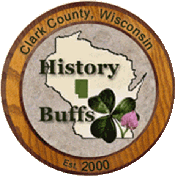Short
Town of Early Mentor History
Clark
County, Wisconsin
Transcribed by Stan.
Source: HUMBIRD ENTERPRISE (Humbird, Clark County, Wis.) 01/13/1906
Taken from address by Orin Wilson held in Neillsville July 4, 1876
At the request of this Centennial Committee, I write a short history of that
part of Clark County, Wis. now comprising the town of Mentor.
In June 1856, the first settlers landed in the town of Mentor with our oxen,
cows, pings and chickens, our covered wagons being our only shelter. There was
not a vestige of a road, no mark of civilization, with the exception of
government surveys. Our colony consisted of twelve families, coming from
different parts of the world, five from England, two from Erin's Isle, one from
Germany, three from the state of New York, and one from the state of
Pennsylvania.
As the season was far advanced our first work was with our noble oxen to
break some of the prairie soil and plant and sow such grain and vegetables as
would ripen. While a husbandmen would break and harrow in the forenoon the wife
and children, with their baskets filled with choice seed, would plant in the
afternoon. But a few days elapsed ere we could look from our covered wagons on
small fields of growing grain and garden vegetables.
The next business that called our attention was to build house and we built
them in old time style, not as nowadays, with sawed and planed lumber and all
covered with paint, with a tower on top and all such modern improvements. We
built them of logs. They were all straight and sound and hewed down on the
inside; they were covered with hollows and rounds, and our floors were made of
good substantial plank split out with the ax. The last of June we moved into our
log cabins; we were all happy and contented.
Wild berries were abundant. Strawberries were the first to ripen and were a
luxury. Next came the blueberries. The hillsides were blue with them, yes they
were slick, and thick too. Many a time have two of us filled a large washtub in
an hour. We used to pickle them by the barrel and dry them by the bushel and
preserved and can them. Well we might be called the whortleberry farmers.
Well do I remember our first 4th of July. We were all speakers and
all listeners. We talked over our nation and the great improvements it had made
in eighty years, and then we had our picnic dinner! We ate sumptuously and went
home feeling well.
The first summer was a busy one and soon passed away. We joined teams and
broke a few acres each, built log stables, and put up some wild hay to winter
our stock. Each had a small field of buckwheat, it was the staple product.
Winter came in earnest and hung right by until spring. The principal
excitement that winter was hunting deer and elk. We killed a plenty for our
meat, used their tallow for our lights and their hides for mittens and
moccasins. The snow was so deep that we could not go afoot, so we hunted on
snowshoes. But he long winter disappeared. The next summer a saw mill was built
at the edge of our town by D. B. Travis. Our nearest grist mill was Wright's,
and was the only grist mill in the country, and there we took our wheat and
corns and Moses Ground it for us.
Our nearest post office was Black River Falls, a distance of twenty miles;
also the nearest point to a store. That summer there was a post office
established in Garden Valley on the Black River Falls and Eau Claire Stage line.
Union and harmony prevailed in our neighborhood. When one went to the post
office he brought the mail for us all. Likewise, when one would go to the store
the rest would send by him for their dry good and groceries.
That summer we petitioned to our county father, James O'Neill to come and lay
out a highway for us. In answer to our call he came, bringing with him one of
the side board, S. C. Boardman, and the county surveyor, and laid out a road
through the town. This road proved to be the best route from the upper
Trempealeau valley to Augusta, and is toady the main thoroughfare. The next
summer a road was laid out and made passable through the forest from Neillsville
to our little settlement, a distance of sixteen miles. Previous to this we could
reach the county seat only by way of Wright's Mill. (Apparently this was
continued in the next week's newspaper, but I do not have a copy at this time)
